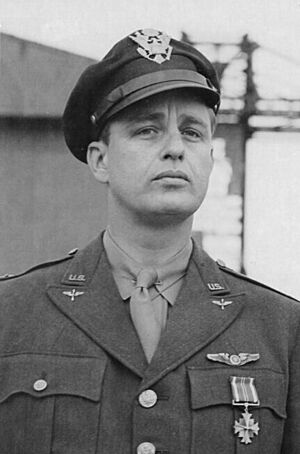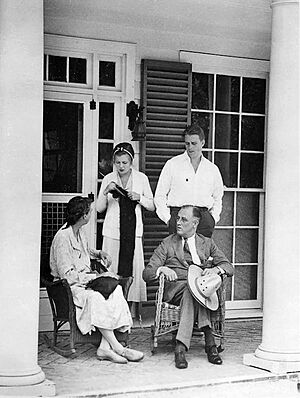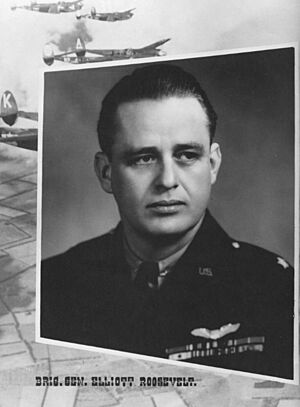Elliott Roosevelt (general) facts for kids
Quick facts for kids
Elliott Roosevelt
|
|
|---|---|

Roosevelt receiving the Distinguished Flying Cross in Algiers
|
|
| 24th Mayor of Miami Beach, Florida | |
| In office June 1, 1965 – June 6, 1967 |
|
| Preceded by | Melvin Richard |
| Succeeded by | Jay Dermer |
| Personal details | |
| Born | September 23, 1910 New York City, New York, U.S. |
| Died | October 27, 1990 (aged 80) Scottsdale, Arizona, U.S. |
| Cause of death | Heart and liver failure |
| Spouses |
Elizabeth Browning Donner
(m. 1932; div. 1933)Ruth Josephine Googins
(m. 1933; div. 1944)Faye Emerson
(m. 1944; div. 1950)Minnewa Bell
(m. 1951; div. 1960)Patricia Peabody Whitehead
(m. 1960) |
| Children | 5 |
| Parents | Franklin Delano Roosevelt Anna Eleanor Roosevelt |
| Relatives | Roosevelt family |
| Education | Hun School of Princeton Groton School |
| Military service | |
| Allegiance | United States |
| Branch/service | United States Army Air Forces |
| Years of service | 1940–1945 |
| Rank | Brigadier General |
| Commands | 90th Photographic Wing 325th Photographic Wing |
| Battles/wars | World War II |
| Awards | Legion of Merit Distinguished Flying Cross Air Medal (12) |
Elliott Roosevelt (born September 23, 1910 – died October 27, 1990) was an American aviation expert and a military officer. He served in the United States Army Air Forces during World War II, reaching the rank of brigadier general. He was a son of President Franklin D. Roosevelt and First Lady Eleanor Roosevelt.
As a commander, Elliott Roosevelt helped develop new ways to take pictures at night from airplanes. He also helped gather important weather information for military operations. After the war, he wrote books, including a mystery series where his mother was the detective. He also worked in broadcasting, ranching, and politics. From 1965 to 1967, he was the 24th mayor of Miami Beach, Florida.
Contents
Growing Up: Elliott's Early Life
Elliott Roosevelt was born to President Franklin D. Roosevelt (1882–1945) and First Lady Eleanor Roosevelt (1884–1962). He was named after his mother's father, Elliott Roosevelt. He had four siblings: Anna, James, Franklin Jr., and John. Another older brother, Franklin, passed away as a baby.
Elliott went to the Hun School of Princeton and Groton School, just like his brothers. However, he decided not to go to Harvard College. Instead, he tried different jobs, starting in advertising. In the 1930s, he began working in broadcasting, even managing parts of the Hearst radio network.
Elliott Roosevelt's Military Service
Elliott Roosevelt was always very interested in flying. In 1933, he briefly managed a small airline called Gilpin Airlines. Later that year, he became an aviation editor for the William Randolph Hearst newspapers. He also worked for the Aeronautical Chamber of Commerce, which is now known as the Aerospace Industries Association. In 1935, he moved to Fort Worth, Texas, and worked in broadcasting and farming.
Joining the Army Air Corps
On his 30th birthday, September 23, 1940, Elliott Roosevelt joined the United States Army Air Corps as a captain. Even though his father was President, military leaders said his appointment was fair. After some training, he worked in intelligence and served with the 21st Reconnaissance Squadron in Gander, Newfoundland.
In 1941, Roosevelt helped find locations for air bases in places like Labrador, Baffin Island, and Greenland. He also checked conditions in Iceland. During this time, he worked closely with his father, President Roosevelt, and British Prime Minister Winston Churchill. He became a specialist in getting supplies, a navigator, and an intelligence officer. By January 1945, he was promoted to brigadier general. Even with poor eyesight, he became a pilot and reportedly flew many combat missions.
Attending Important War Meetings
In August 1941, Elliott and his brother Franklin Jr. joined their father at the Atlantic Conference (Atlantic Charter). This was a secret meeting between President Roosevelt and Prime Minister Churchill. Later, in 1943, Elliott went with his father to other key meetings, including the Casablanca, Cairo, and Tehran Conferences.
At the Tehran Conference, Soviet leader Joseph Stalin suggested a harsh plan for Germany after the war. Elliott Roosevelt supported this idea, which pleased Stalin but angered Churchill.
Leading Reconnaissance Missions
After training as a navigator and bombardier, Elliott Roosevelt received a top-secret mission. He flew hidden reconnaissance flights over the Sahara Desert, especially over French West Africa. These missions were very successful. After this, he was given command of the new 3d Reconnaissance Group in Colorado Springs.
From North Africa, he led his unit in Operation Torch, the invasion of Northwest Africa in November 1942. Roosevelt flew the first U.S. reconnaissance missions in the area using a British de Havilland Mosquito aircraft. He strongly believed that the U.S. military should use this British plane.
Elliott Roosevelt developed new ways to take aerial photos at night. He also captured "before and after" pictures of Rome during its first heavy bombing in July 1943.
Commanding Air Force Units
After investigating reconnaissance issues in the United States, Roosevelt took command of the 8th Air Force's reconnaissance wing in England. This unit was called the 8th Provisional RW, and later the 325th Reconnaissance Wing. During this time, Roosevelt worked on a project to allow planes to fly missions between American and Soviet bases. His units also supported the D-Day invasion of Normandy and bombing missions against German V-weapon sites.
In January 1945, General Arnold ordered that Roosevelt be made a rated pilot. President Roosevelt then submitted his son's name for promotion to brigadier general. Elliott Roosevelt continued in this rank until his father's death in April 1945. His last day of service was VJ-Day, when the war ended.
Elliott Roosevelt commanded several important units:
- 3d Reconnaissance Group: From July to August 1942, and again from September 1942 to March 1943. He flew many reconnaissance missions during the North Africa campaign.
- Northwest African Photographic Reconnaissance Wing: From February to November 1943. This unit included American, British, South African, and French squadrons.
- 90th Photographic Wing: From November 1943 to January 1944. This group provided photographic reconnaissance for different air forces. They scouted airfields, roads, and harbors in Italy.
- 325th Photographic Wing: From August 1944 to April 1945. This unit collected weather information for planning operations. They also flew night photographic missions and supported Operation Market Garden and the Battle of the Bulge.
Roosevelt stated that he flew 89 combat missions and spent 470 hours in combat. He received several awards, including the Distinguished Flying Cross. He also earned the Order of the British Empire, the Croix de Guerre and Legion d'Honneur from France, and the Moroccan Order of Ouissam Alaouite. He ended the war with the Air Medal and eleven clusters.
After the war, Elliott Roosevelt did not have a major role in aviation, though he kept his pilot's license. He briefly served as president of Empire Airlines of New York in 1946.
Life After the War
After his father passed away in 1945, Elliott Roosevelt and his family moved closer to his mother, Eleanor. She often helped him financially. In 1947, Eleanor bought Val-Kill farms, where she lived, and gave the property to Elliott. Later, this property became the Eleanor Roosevelt National Historic Site.
Elliott Roosevelt had many different jobs throughout his life. He owned a radio station network in Texas before the war and lived as a rancher. He later moved to Florida and was elected mayor of Miami Beach in 1965. He served for two years.
In 1972, Roosevelt moved to Portugal. However, he left for England after the Portuguese Carnation Revolution in 1974. He then moved back to the United States, living in different states like Washington, California, and Arizona. Elliott Roosevelt passed away at age 80 from heart and liver failure.
Author and Biographer
Elliott Roosevelt wrote many books. He created a mystery series where his mother, Eleanor Roosevelt, was the detective. One of these books was called Murder and the First Lady (1984).
He also wrote a best-selling book called As He Saw It, which described his experiences with his father during five important war conferences. Elliott also helped edit FDR: His Personal Letters, which was published after the war.
With James Brough, Roosevelt wrote a book about his parents called The Roosevelts of Hyde Park: An Untold Story (1973). This book shared details about his parents' lives and gave insights into his father's journey to becoming President. A follow-up book, A Rendezvous With Destiny, was published in 1975. He also wrote Mother R.: Eleanor Roosevelt's Untold Story (1977) and Eleanor Roosevelt, with Love: A Centenary Remembrance (1984).
Family Life: Marriages and Children

Elliott Roosevelt was married five times:
- On January 16, 1932, he married Elizabeth Browning Donner. They had one son, William Donner Roosevelt (1932–2003), who became an investment banker. They divorced in 1933.
- On July 22, 1933, he married Ruth Josephine Googins. They had three children: Ruth Chandler Roosevelt (1934–2018), Elliott Roosevelt, Jr. (born 1936), and David Boynton Roosevelt (1942–2022). Elliott and Ruth divorced in 1944.
- On December 3, 1944, he married actress Faye Emerson. They divorced in 1950.
- On March 15, 1951, he married Minnewa Bell. They divorced in 1960.
- On November 3, 1960, he married Patricia Peabody Whitehead. She had four children from a previous marriage, and Elliott adopted all of them. Their only child together, Livingston Delano Roosevelt, passed away as an infant in 1962.
Military Awards and Honors
Elliott Roosevelt received several military decorations and awards for his service:
| Legion of Merit | Distinguished Flying Cross | ||
| Air Medal with eleven clusters | American Defense Service Medal | American Campaign Medal | European-African-Middle Eastern Campaign Medal with seven stars |
| World War II Victory Medal | Commander of the Order of the British Empire (United Kingdom) |
Knight of the Legion of Honour (France) | Croix de Guerre with palm (France) |


